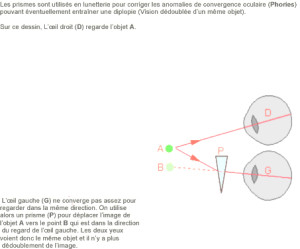The convergence insufficiency consists of insufficient convergence of the eyes during near vision as in the case of reading. The eye that does not converge enough discomfort the other eye, hence discomfort. This muscle is a problem, that of the eye muscles, the number of six eye muscles by. According to the affected muscle or muscles you have a different clinical picture. All these muscle disorders are grouped under the name heterophoria.
Of all these troubles convergence insufficiency is the most common.
Knowledge of heterophoria is paramount, as unrest in itself, ocular motility, as an introduction to strabology and as data to be taken in account in the optical correction of vision defects.
There actually has a muscle imbalance, often hidden by an effort of fusion. Arguably the orthophories (no muscle imbalance) are rare. Heterophoria by cons are part of the daily routine consultations. Some authors put the figure at 75% of the population that would be reached. There is a weakness of one or more muscles; the visual axes are not exactly parallel; images forming on mismatched retinal points, there is a risk of diplopia, without the aid of reflex fusion. We are constantly in a precarious state of muscular balance. The unconscious effort merger maintains a balance. To remedy the faulty muscles constantly provide additional work. Hence muscle fatigue. Strabismus is latent. It is the fusion reflex amplitude and saving the situation. If amplitude low melting or general fatigue the muscle disorder is not overcome and heterophoria becomes heterotropia or strabismus.
SYMPTOMS Heterophoria Often the condition is asymptomatic, because it is very pronounced and the fusion power is normal and is discovered during a routine examination. This is the case of esophoria (eyes convergence excess) and exophoria (eyes convergence insufficiency). The hyperphoria (an eye excess elevation) by cons is always annoying, especially since it comes in the last two. When the patients complain that the deviation has become significant in the order of 5 to 10 ° at most; then they talk:
– Visual fatigue, tingling, burning and tearing in near vision, including reading, forcing them to interrupt their activity.
– A conjunctival hyperemia is possible as well as photophobia. The spread of computer work in the office or at home, multiplied complaints. Symptoms from constant efforts exerted to maintain fusion orthophoria. The important cyclophoria can cause major problems: The vertical lines appear tilted, leaning the tables, ready to crumble away. Many a time the head is inclined on a shoulder in compensation.
– Headaches are common; they are diffuse or frontal; or not accompanied by dizziness; always asked if there was nausea or vomiting because patients do not necessarily relate to their visual fatigue. They admit to having been both a CT scan or MRI which have been found normal.
– We also asked if there are back pain or neck. Symptoms are exacerbated by late afternoon. Installation is gradual, sometimes sudden end of a particularly tiring visual work. Distance vision is also a purveyor of its share of visual fatigue; it may include a visit to a gallery picture, theater, a cinema, auto driving or travel by train. The occupation of the patient should be noted, is most often the source of the complaint. The circumstances of the occurrence or worsening are clear: more than harrassante other day, a systemic disease, pregnancy, lactation, stress, annoyances, worries or anxieties. There are the rest, which is likely to ease symptoms, or treatment, or the passage strabismus is possible, though rare.
The diagnosis of heterophoria heterophorias are so frequent and their impact is so significant that their research should be part of the usual pattern, mandatory eye examinations. Mandatory since it is often their signs asthenopic subject of consultation, important since the optical correction differs according to the type of heterophoria mandatory since the discovery of a heterophoria requires care other than prescription glasses.
TREATMENTS
The treatment of convergence insufficiency include rehabilitation sessions of eye muscles or defaulting. Rehabilitation is provided by Orthoptists. Orthoptics is an allied health specialty. Usually ten sessions is required.
It uses the prismation on failure of rehabilitation.
Prismation of convergence insufficiency
Prismation of convergence insufficiency




